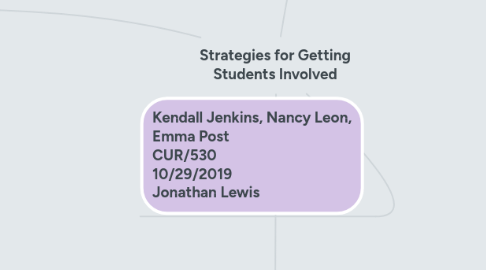Strategies for Getting Students Involved
Door Emma Post


1. Collaboration
1.1. Definition: Collaboration is when students are working in small groups or with a partner. Students collaborate with one another as they brainstorm ideas, discuss points of view, find a solution to a problem and/or complete a task. Collaboration can take place either inside or outside a classroom (2019).
1.2. Benefits: When students are given the opportunity to collaborate with one another, they are exposed to different point of view and learn to work with diverse personalities. In the meanwhile, students develop stronger communication, problem solving and leadership skills; all these benefits are very valuable to learners as they are useful outside the classroom (2019).
1.3. As student collaboration is being implemented in class, and to avoid any bias against this approach, it is important to create team norms to guide students behaviors as they engage with one another. Also, students must be clear on the role and responsibilities of each team member.
1.4. Project Based Learning: When students collaborate in this setting, they are able to share their knowledge, brainstorm ideas, and conduct research in order to solve a problem or complete a project (2018).
1.5. Google: Nowadays, Google has become a popular tool for students to digitally collaborate in groups as all team members can simultaneously contribute to a document without being in the same room (2018.
1.6. Discussions: Student to student collaboration can be as simple as participating in a class or group discussion as students learn from one another's' ideas or points of views.
1.7. Reference:
1.7.1. Collaborative Learning (2019). Center for Teaching Innovation. Retrieved from: https://teaching.cornell.edu/teaching-resources/engaging-students/collaborative-learning
1.7.2. Poth, R. (2018). Collaboration: Bringing Students together to Promote Learning. Retrieved from: Collaboration: Bringing Students Together to Promote Learning | Getting Smart
2. Assessment
2.1. We can help our students’ by teaching them to be more analytic about their own learning, by giving them class time and a structure to examine their own work in relation to previously explained criteria, and by clarifying how they can improve their work. Some example's to use in the classroom are: 1) helping students to identify their mistakes by providing them with item analyses of their tests or rubric scored projects. 2) Set up a system in the classroom to involve students in thinking about their mistakes. Give them time to consider why they made the mistake, and Help them to understand what they will do differently next time. 3)Thinking About Doing Better activity is an example of a handout for helping students to analyze their mistakes on a forced-choice or short answer test. Each student has a form and works in a group of two or three.
2.2. Definition: Assessment refers to the wide variety of methods or tools that educators use to evaluate, measure, and document the academic readiness, learning progress, skill acquisition, or educational needs of students.
2.3. Elimination of Bias : Every form of assessment of learning has bias. This bias may be hidden, or it may be quite obvious. Assessment is a proxy for what we want to measure – learning. One bias therefore is the tendency to forget that we are not actually measuring learning, we are measuring a proxy for learning.
2.4. Benefits of Assessment: They affect decisions about grades, placement, advancement, instructional needs, curriculum, and, in some cases, funding. Assessment inspire us to Provides diagnostic feedback, Helps educators set standards,Evaluates progress, Relates to a student's progress, Motivates performance for student self-evaluation and teacher self evaluation.
2.5. Sindelar, N. (2010) Assessment-Powered Teaching. Thousand Oaks, CA.: Corwin Press Edutopia. (2008, July 15). ASSESSMENT. Retrieved from https://www.edutopia.org/assessment-guide-importance. O'Neil, C. (2013, June 11). Bias in Assessment. Retrieved from https://davidwees.com/content/bias-assessment/.
3. Kendall Jenkins, Nancy Leon, Emma Post CUR/530 10/29/2019 Jonathan Lewis
4. Peer Review
4.1. Definition: Peer Review is when students share their work with peers and receive constructive feedback in order to revise and improve their work (2019).
4.2. Benefits: Students are more engaged when working with their peers and thrive from being able to teach their peers. When hearing feedback from other students instead of teachers or parents, students are more likely to take the feedback seriously (Alrubail, 2015).
4.3. In order to eliminate bias for this type of assessment, it might be best to take the names off of the assignment prior to having peers review it.
4.4. Scaffolding peer reviews by giving students examples to use as a model will help them understand how to provide constructive feedback to their peers.
4.5. Sometimes students may feel overwhelmed with reviewing an entire project or paper so giving them one area to focus on during a peer review may help ease anxiety and provide better feedback.
4.6. Ensuring that there is a community that will allow students to provide and receive constructive feedback without getting upset and understanding that it is meant to help them revise and improve their work.
4.7. References:
4.7.1. Cassel, S. (2018, July 9). Peer Review Done Right. Retrieved from https://www.edutopia.org/article/peer-review-done-right.
4.7.2. Alrubail, R. (2015, December 17). The Power of Peer Feedback. Retrieved from https://www.edutopia.org/discussion/power-peer-feedback.
4.7.3. Peer Review - ReadWriteThink. (n.d.). Retrieved from Peer Review - ReadWriteThink
